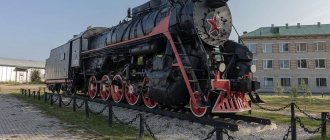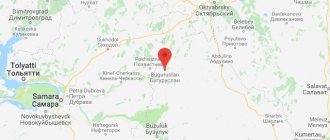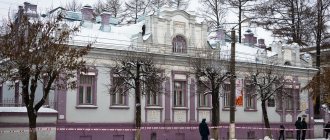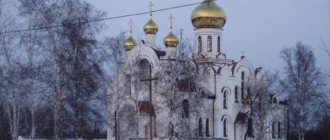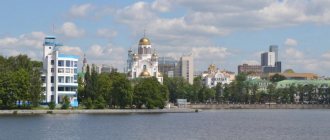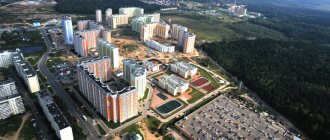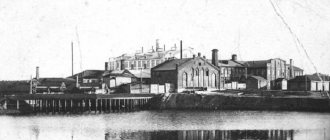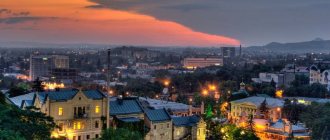Our special project “ABC of Legendary Cities” ends with one of the centers of the Urals, the birthplace of the Dymkovo toy.
- the city of
Vyatka, now called Kirov.
The history of the city will be of interest to both adherents of official history and seekers of historical inconsistencies and secrets.
Vyatka city panorama
If we take the generally accepted picture of the past, then Vyatka was founded in 1181 by the Novgorodians
-that is, it is
one of the oldest cities of Ancient Russia
(if we keep in mind the spheres of influence of Novgorod and Muscovy), and also the easternmost. This alone is already quite curious, however, in the school history of Vyatka, if it is mentioned at all, it is so superficially and fleetingly that one can say that it is not mentioned at all, as if such a city never existed or its past is not of particular importance.
At the same time, the history of Vyatka
is described
a document of the late 17th century
, recognized by official historians, but little known to the general public, entitled
“The Tale of the Country of Vyatka.”
It begins with the legend about Sloven and Rus (see Slovensk), already known to us, which tells
about the origin of the Rus as such and their history since the time of the flood, Noah and his descendants
.
Next we talk about the formation of ancient Russian statehood
, and the central place is given to Novgorod, but other capital cities of Ancient Russia that are “familiar to us” are almost not mentioned there. Whether this is due to the fact that the first settlers of Vyatka, according to available data, were Novgorodians or something else is unknown...
Vsevolod Ivanov
As for the history of the Vyatka land itself, according to this “Tale”, Novgorodians begin to move to the Kama River and build the first fortified settlements in 1174
(6682 summer):
In the summer of 6682, the inhabitants of Novgorod, the Samovlass, separated from the border of Velikago Novagrad with their retinue and sailed in boats down the Volga River and reached the Kama River and stayed there for some time and set up a small town along the Kama River for their habitation and heard about the Vyatka River and and the Chudi Ostyaks living along it, possessing many lands and holdings, built trenches and earthen will...
In 1181 (6689 years) in a difficult battle, which is compared with the victory of Alexander Nevskaya over the Swedes, the Novgorodians captured the Chudsky town that belonged to the Chud (white-eyed?)
.
In the chronicle it is called Bolvansky (obviously, based on the number of temples and idols standing there) and is described as “strong”. Subsequently, this city received a new name Nikulitsyn.
Another Chud
city - Konsharov (Kaksharov)
, after the flight of most of the Chud and the opening of the gates to the Novgorodians,
becomes Kotelnich or Kotelnin
.
Nikolay Fomin. Prince
Finally, the Novgorod settlers
Nikulitsyn and Kotelnich
make
at a general meeting
to build a common third city
, between the two conquered from Chud, in order to strengthen their power over these lands.
The location was chosen on a mountain near the mouth of the Khlynovitsa River:
...the Novgorodians who agreed, the owners of Bokhvansky town and Koksharov, demand that they build a common city and a strong castle
... And having chosen a beautiful place above the Vyatka River near the mouth of Khlynovitsa, others decided at that time that birds were flying along the river and the crowing of the trees and that is why that river was called Khlynovitsa, on a high mountain that now calls Kikimorskaya a place because it is convenient for universal settlement and from that The mountains are glorious springs flowing out of many.
And by common agreement, in the appointed time, the people of many Novgorodians who gathered on this mountain began to build a city, prepare a place to build wood and prepare how to create a city... and sprinkled it with the Khlynov city of the river for the sake of Khlynovitsa.
Andrey Klimenko
By the way, who was that white-eyed wonder?
and why this people is covered in so many legends is not known with certainty. The legends themselves are also often extremely contradictory - sometimes the Chud are giant heroes, sometimes, on the contrary, they are short people who can suddenly disappear underground. They are often described as strong and fierce warriors, or as sages who possess much knowledge unknown to others - this is where “chud” comes from - that is, “wonderful”, “strange”, “causing surprise”. “White-eyed” seems to indicate a light (blue?) iris. The Chud are associated with another legendary people - the Sirtya, and with artifacts of the Perm animal style, and most importantly - everywhere in the North and beyond the Urals there are legends that here and there (often in caves) lie the remains of a certain Chud town. They themselves seemed to have disappeared somewhere along the roads of history. It is believed that the Chud population was completely assimilated with the Komi, Russians and Vepsians. Most historians classify them as Finno-Ugric, however, other Finno-Ugric tribes (Komi-Zyryans, Permians) very clearly distance themselves from the Chud and do not consider them a related people, and, for example, Svetlana Zharnikova is a famous ethnographer, linguist and expert on the Russian North , confidently said that these are people of Slavic origin.
N.K. Roerich . Chud underground
Vyatka is governed by the People's Assembly according to the model of Novgorod
and does not recognize the supremacy of any other principalities. Residents begin to call themselves Vyatchans, and their land - the country (!) Vyatka.
And so the Novgorodians began to live in common with autocratic rights and the possession of their inhabitants and their fatherly morals and laws and customs of Novgorod in the name of many years before the possession of the great princes of Russia and were nicknamed the Vyatchans of the river for the sake of Vyatka.
From the text of the chronicle it is clear that Vyatka was a desirable territory both for other Russian principalities, torn apart by civil strife, and for neighboring peoples,
however, despite repeated attacks, Vyatchany was never captured by anyone.
At the time of the 19th century, the Russian princes who had property gave their cities to the people who came to Vyatka with various armies
in the great assembly, everyone
wanted to take the country of Vyatka
into their citizenship
and nothing succeeded,
especially from the Chudi Ostyaks and Cheremis and the Besurmyans and Nagayts from below the Volga River and from the Kazan Tatars and from the Zakamsky settled Novgorodians, the Vyatchans had
a lot of oppression of their property and ruin by fighting many times and in no way we have byahu.
Nikolay Fomin. Series “Conquest of Siberia”
In all-Russian chronicles, Vyatka was first mentioned in 1374
in connection with the campaign of the Novgorod Ushkuiniki against Volga Bulgaria.
In the summer of 6882 (1374) the Ushkun bandits, 90 Ushkunites, went down the Vyatka River, plundered Vyatka and took the Bulgarians.
It seems that ancient Vyatka had significant military power
and often
participated both in wars between Russian principalities and in battles with the Horde
.
It is known that in 1412, a certain major battle took place between the Vyatichi and the Ustyug (Veliky Ustyug),
a holiday called “Svistoplaska”
(or “Vyatka whistling”) arose and took root in the Vyatka province It fell on the fourth Saturday after Easter and was a noisy fun, with songs, dances, whistling, rolling clay balls down the mountain and fist fights. A fair was also organized for the holiday, where toys in the form of girls, boys, bears, horses, goats, etc. were sold. with characteristic Dymkovo painting. Many of them were whistles for use at the holiday.
Dymkovo whistle
In 1432–1453, Vyatka acted on the side of the Galich-Mer principality (Kostroma region) against Muscovy. After the defeat of the first, the Vyatchans built a wooden Kremlin and, probably (but not for sure!), renamed their city Khlynov
.
Within a couple of years - after the campaigns of the Moscow princes (Vasily Vasilyevich) against the city in 1457 and 1459 - Vyatka (Khlynov) formally came under the control of Moscow, and its troops even took part in Muscovy’s military campaigns against Novgorod. In 1471 (6979 years) the Vyatchans, sailing along the Volga on ships, captured the khan's capital, Sarai
.
The city of
Sarai-Batu (an ethnographic reconstruction museum created for the filming of the film “Horde” not far from the supposed location of the real ancient city)
Then in 1477 the Kazan Tsar captured Vyatka and ravaged the city
and will captivate many Vyatchans. At the same time, the latter simultaneously continue to oppose the Moscow princes. In 1489, under Ivan III, on the second attempt, the city was finally subjugated to Muscovy and included in the Moscow state. Clashes between the Vyatchans and the Khans stopped only with the capture of Kazan by Ivan the Terrible in 1552; in this year the Khlynovites already took part in the campaign as part of the Moscow army.
N.K. Roerich . Conquest of Kazan
History of the city of Kirov (Vyatka).
The first nationalities on the territory of today's capital of the Kirov region were formed in the 7th-10th centuries AD. In 1374, the first city was formed on the banks of the Vyatka River; it was founded by the Novgorod Ushkuiniki (robbers). The name of the city comes from the Khlynovitsa river.
Since then, Khlynov managed to visit the patrimony of the Vladimir-Suzdal principality, experience the invasion of the Tatars, and was eventually annexed to the Moscow principality.
Trifonov Monastery
On September 11, 1780, by decree of Catherine II, Khlynov was renamed Vyatka and removed from the Kazan province (before that it was also part of the Siberian province, and before the reform of Peter I an independent district town). In 1797, the Vyatka governorate was transformed into a province, which contributed to the further growth of the city. Various industries were developing, trade routes were developing. By the end of the 19th century, Vyatka was a developed trade and craft city.
The city received the name Kirov in memory of S.M. Kirov by decision of the Central Executive Committee of the USSR, this happened on December 5, 1934.
View of the Diorama
Foundation of Vyatka
The history of Vyatka, according to the “Tale of the Vyatka Country” (late 17th century), begins with the founding of the city by Novgorodians in 1181. By this time they had already founded Nikulitsyn and Kotelnich, and decided to create a single center. The first mention of the city of Vyatka (or Vyatka land) in all-Russian chronicles dates back to 1374 in connection with the campaign of the Novgorod ushkuiniki against the capital of Volga Bulgaria, the city of Bulgar. This name is the generally accepted definition of what Kirov used to be called.
Sights of the city of Kirov.
Vyatsky Assumption Trifonov Monastery - when in 1489 Khlynov finally became part of the Moscow state, Ivan the Terrible sent a letter to the city about the construction of a wooden monastery in Khlynov. This happened on June 2, 1580, the monastery was named Trifonov in honor of its founder - St. Tryphon, the Vyatka Wonderworker. In 1689, the Assumption Cathedral of the Trifonov Monastery was built from stone, which has survived to this day. Now it is the most valuable monument of the first stone construction on Vyatka land.
Novodevichy Transfiguration Monastery - founded in 1624 as a convent. The building of the Transfiguration Church of this monastery, built in 1696, which has survived to this day, is an interesting example of Vyatka architecture (now it houses the “School of Higher Sports Excellence”, Dinamovsky Proezd, 6).
The ensemble of the Trinity Church in Makarya, the Gate and the fence - the first buildings were built in 1770, and have not survived to this day. This is due to both the reconstruction of buildings and their destruction. Now we can see the restored version of 1988 (architect of the reconstruction project E.L. Skopin). The church gate is rightfully considered an architectural pearl. They repeated the baroque forms of the temple, harmoniously complementing the unified stylistic concept of the churchyard. In the center of the three-part composition is a high passage arch, completed by a spectacular raising of the converging volutes of the cornice and dome.
Feodorovskaya Church - located on the Green Embankment - almost on the very shore of Vyatka. The first church on the same site was opened in honor of the Feodorovskaya Icon of the Mother of God in 1918. Having survived the revolutionary years, as well as the Great Patriotic War, it was blown up in 1963. In 1974, the city authorities wanted to erect a monument on this holy place in honor of the 600th anniversary of the city of Kirov, but nothing came of it. For more than 30 years, the prayer site was a wasteland. The opening of the modern temple took place on August 25, 2007.
I would also like to highlight the following attractions:
Kirov Drama Theater - the first wooden theater building was built in 1877. The new building that we can see now was built in a very short time in 1935. Its construction was carried out according to the design of Moscow architects Burov and Fedorov. The theater season was opened with the play “Lyubov Yarovaya” in 1939. During the war, the writer Evgeny Schwartz came to Kirov. In Kirov he wrote the plays “One Night” and “The Distant Land”. To date, the theater has performed more than 30 performances for both adult and young audiences.
Drelevsky Street - before the revolution, this street was called Spasskaya. Many historical and cultural objects have been preserved here, representing various eras in the history of not only Vyatka, but also Kirov. Part of the street is pedestrian (starting from the intersection with Lenin Street), and there are shops where you can buy various souvenirs. The possibility of making the entire Drevlevsky Street pedestrian in the likeness of Moscow's Arbat is being discussed.
Park named after S.M. Kirov - here you can just take a walk and feed the ducks, as well as ride the rides near the circus. The park complex includes a circus, a diorama, the Vyatka hotel, a pond and a summer playground with attractions. The park occupies a block between Oktyabrsky Prospekt, Krasnoarmeyskaya, Gorky and Azin streets. Between two ponds in the park there is a small waterfall with two bridges; this place is very popular among newlyweds. The diorama building rises above the upper pond.
A diorama is a museum, inside of which there is a large canvas depicting the events of 1917. The events took place at the intersection of Nikolaevskaya and Spaskaya streets. Now these streets are called Lenin Street and Drevlevsky Street.
A wishing tree with an ear is an architectural structure in the form of a tree on which an ear is located. You can whisper your wishes to this ear. Residents and guests of Kirov often take the opportunity to ask for something from this wonderful hearing aid.
Alexander Garden - founded in 1825 after Alexander I visited Vyatka. It is the central and one of the oldest parks in the Kirov region, which offers an excellent view of the Vyatka River. The entrance portico and cast-iron fence were designed in 1838-1840 according to the design of the Moscow architect Vitberg, who at that time was in exile in Vyatka. The central pavilion and the coastal rotunda were built according to the drawings of the Vyatka provincial architect Alexander Egorovich Timofeev in 1835.
Vyatka Kunstkamera - opened in 1992 in the house of the merchant Senilov. The museum consists of five halls, inside of which there are exhibits reflecting the era of the 19th century and urban life. Visitors can also view collections of watches, artistic metal products, collections of porcelain and earthenware, furniture and clothing attributes.
Alexander's Church - the opening of the church took place on August 31, 1903. Local Catholics had been waiting for this day since 1892, when, at the request of exiled Poles, Vyatka Governor A.F. Anisin, with the approval of the Minister of Internal Affairs, allowed local Catholics to open a prayer house. The temple with a plan in the form of a Latin cross is a single-nave building. The lowered apse and towers flanking the portal, with metal crosses on the light “lanterns”-domes, and the open belfry above the middle cross impart plasticity to the volumetric-spatial construction of the building.
Kirov Puppet Theater named after A.N. Afanasyev - founded in 1935, and is one of the oldest in Russia. In 1941, the theater was headed by actor and director Anatoly Nikolaevich Afanasyev, the founder of the theater dynasty, whose name was given to the theater in 2009. In 2009, a new building was built for the theater.
The A.S. Green Museum was built on the site where the outstanding writer used to live. In the museum you can see exhibits related to the life of the writer. A.S. Green lived in Kirov (Vyatka) in his youth and childhood. The museum’s collection contains items from the 19th – early 20th centuries - furniture, books by A.S. Green’s favorite authors, toys and school supplies.
House-Museum of M.E. Saltykov-Shchedrin - located in the house where M.E. lived from 1848 to 1855. Saltykov-Shchedrin, serving exile in Vyatka. The basis of the museum was the writer’s memorial office. The exhibition recreates the interiors of the mid-19th century. M.E. Saltykov’s personal belongings were not preserved. The museum was opened as a literary museum with a memorial office for the writer, therefore, according to tradition, exhibitions are organized annually to introduce the work of fellow countrymen writers.
Museum of K. E. Tsiolkovsky, Aviation and Cosmonautics - the museum is located in a building that belonged to the Vyatka merchants Shuravin. Later, the Tsiolkovsky family lived in this house. The museum is dedicated to the life and work of the scientist and founder of astronautics. The museum displays furniture that belonged to the Tsiolkovsky family, as well as household items from the 19th century. You can also look at the personal belongings of cosmonauts and pilots V.P. Savinykh and A.A. Serebrova.
Bulychev's mansion - built in 1911 for the merchant Tikhon Filippovich Bulychev by the architect Ivan Apollonovich Charushin. Located on Lenina Street, 96. This beautiful castle with an openwork cast-iron fence is an example of Gothic architecture. On the façade there are strict double-headed eagles. There is a tower at the corner of the building.
The house of A.Yu.Levitsky is a cottage house built in 1910 according to the design of E.K. Nykvist in the Art Nouveau style. Its shape is reminiscent of residential buildings in England, Holland and the Baltic countries. The provincial doctor Levitsky lived here.
Kirov Museum of Railway Transport - located on Karl Marx Street, house 147. It was opened on the 100th anniversary in honor of the laying of the first railway through Vyatka. In the museum you can get acquainted with the history of the development of railway transport in the Kirov region, and in Russia as a whole. Various exhibits are presented. One of the most interesting is a model of a railway station from the time the first trains appeared. In front of the entrance to the museum is the main exhibit - the steam locomotive Er 788-74.
Dynamo Stadium - Located on Moskovskaya Street, 1 V. Its capacity is 10,000 spectators. It is an open stadium for competitions and mass skating. There are a total of 6 operating stadiums in Kirov. It is also worth highlighting the Rodina stadium, where the nationally known hockey team Rodina plays.
Victory Park - located at the intersection of Lomonosov and Lepse streets. There are cafes, fountains, and various attractions for children and adults. Victory Park was laid out on the site where there once was a village. Many residents of this village took part in the Great Patriotic War.
Botanical Garden - located on Karl Marx Street, 95. The history of this wonderful place began in 1912. Its founder was A.A. Istomin, who bought the land and founded a private Botanical Garden here. The best gardeners, artists and architects of St. Petersburg worked on the project. The main part of the garden was planted in 1913. Most of these are imported plants. In the same year, greenhouses and an intricate pool in the shape of the Black Sea with fountains were built. The grotto from which the spring flows was especially good. Unfortunately, of all this splendor, only the swimming pool remains today. The Kirov Botanical Garden is a real open-air museum that includes many representatives of the plant world and their varieties.
Park named after Yuri Gagarin - originally there was a square on which the Alexander Nevsky Cathedral was built in 1864. In 1894, the territory was surrounded by a wonderful cast-iron fence and a park was laid out. Unfortunately, the Cathedral was blown up in 1938, and a pile of broken bricks remained in its place for a long time. Then there was a collective farm market, and even later a zoo. This place was now called Revolution Square. In the 60s of the twentieth century, a television center building and a philharmonic society were built here, many attractions appeared, the alleys were landscaped, and the park itself received a new sonorous name.
